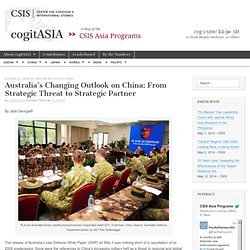

About 1,650 jobs to go in major shake-up of Defence bureaucracy. Updated About 1,650 job losses and a change to the way Australia's military service chiefs work will form part of the biggest shake-up of Defence in more than two decades.

Defence Minister Kevin Andrews has released the long-awaited First Principles review along with the Government's response to try to improve the efficiency of Defence. The review, led by former Rio Tinto managing director David Peever, makes 76 recommendations, including re-absorbing the Government agency which purchases military equipment into the Defence department. "We're looking at a new structure that there will not be DMO (the Defence Materiel Organisation) in the future, there will be a new capability and sustainment group within Defence," he said.
The DMO purchases and maintains military equipment required by the Defence Force and approved by Government. Last year it presided over a budget of more than $12 billion. The review also found about 1,650 fewer public service jobs would be needed. "Defence is ready for it. Hackneywick1 : @BlogsofWar In Oz mil retirees... Australian Government, Department of Defence - Pale Moon.
The Prime Minister and the Minister for Defence have announced that Defence will produce a new White Paper to be completed in 2015.

Defence White Papers are the Government's most important guidance about Australia's long-term defence capability. They provide an opportunity for the Government and community to understand the opportunities and challenges for Australia's future defence and security needs. The 2015 Defence White Paper will align defence policy with military strategy and deliver an affordable Australian Defence Force structure. The development process for the White Paper will involve a comprehensive consultation process, with input from across Government, industry, the Australian public, our allies and regional partners. Australian Government, Department of Defence. The 2013 Defence White Paper was released on 3 May 2013 by the Prime Minister, Julia Gillard, and Minister for Defence, Stephen Smith.

The Government brought forward delivery of the new White Paper by one year from its original 2014 timetable to address a number of significant international and domestic developments influencing Australia’s national security and defence posture internationally and domestically that have emerged since the 2009 Defence White Paper. WP_2013_web. Defence White Paper round-up - Pale Moon. Australia Strives to Balance China and the United States - NYTimes.com - Pale Moon. Australian armed forces concerned over safety of Pakistan's nukes Read mor - Pale Moon.
Australia’s Changing Outlook on China: From Strategic Threat to Strategic Partner. By Jack Georgieff PLA and Australian troops meeting during Exercise Cooperation Spirit 2011, in Sichuan, China.

Source: Australian Defence Department photo, by SGT Rob Nyffenegger. The release of Australia’s new Defence White Paper (DWP) on May 3 was nothing short of a repudiation of its 2009 predecessor. Gone were the references to China’s increasing military heft as a threat to regional and global stability. In its place, the DWP declared that both the United States and China seek a mix of cooperation and competition but not outright conflict. The DWP tonal shift is also part of recent pattern of behavior from Australia that is beneficial from the perspective of U.S. strategic interests in stability. But not all are convinced by this. “Containing” China is a red herring. Indeed the other aspects of Gillard’s announcement last month tightening links with China relate to many soft power measures. Global Security Newswire - Australia Eliminates Old Chemical Weapons.
PrintShareEmailTwitterFacebookLinkedIn Australia's armed forces have wrapped up the elimination of 140 mustard blister agent munitions disinterred in 2009 from the site of a World War II-era U.S. military base, Australian Broadcasting reported on Thursday (see GSN, March 22).

The munitions -- recovered at the former installation near Columboola -- remained dangerous even after six decades, Australian Parliamentary Defense Secretary David Feeney said. Authorities shut down the area and consulted with U.S. specialists in dealing with the weapons. A sealed container was assembled at the former base for destroying the munitions. The effort cost more than $36 million, according to a figure offered by Feeney (Fidelis Rego, Australian Broadcasting, June 2).
Astrium would act as the main contractor for the planned Mailly-de-Camp facility, which is intended to process 46 tons of the weapons on an annual basis starting in 2015. Could Australia fight China alone? Should Australia ever contemplate going to war with China (or any other Asian great power) by ourselves, rather than as junior partner in a US–led coalition?
If so, under what circumstances? Sam's perceptive response to me on 'fighting China alone' suggests slightly complicated answers to both questions. But the complexities are worth exploring, because these are perhaps the most important questions that Australian strategic policy has confronted in forty years. Let's take the second question first. What are the situations in which we might contemplate fighting China alone?